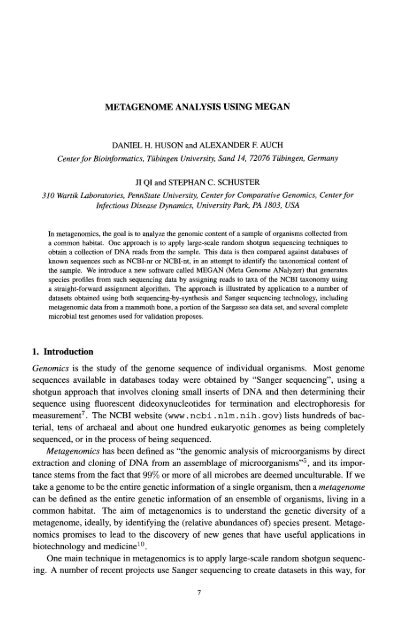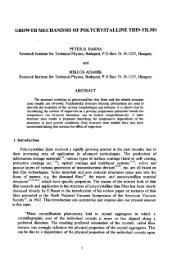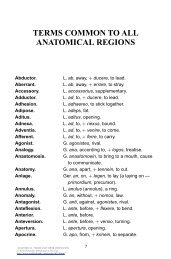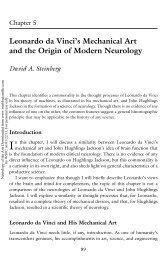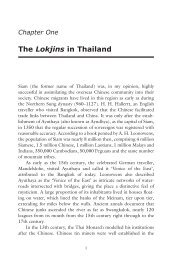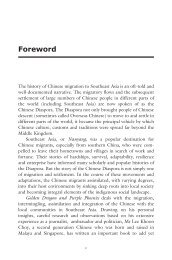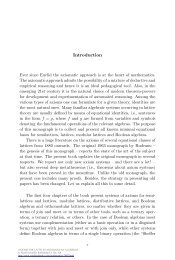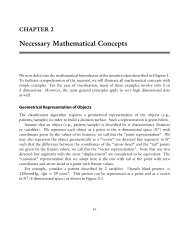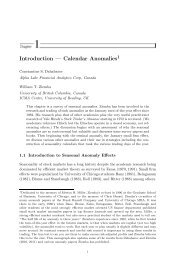Metagenome Analysis Using Megan - Asian Scientist Magazine
Metagenome Analysis Using Megan - Asian Scientist Magazine
Metagenome Analysis Using Megan - Asian Scientist Magazine
Create successful ePaper yourself
Turn your PDF publications into a flip-book with our unique Google optimized e-Paper software.
10ther, a total of 16,972 reads are assigned to Bacteria, 761 to Archea and 152 to viruses, respectively.These numbers are slightly lower than previously reported' due to our slightlymore conservative settings. MEGAN can be used to summarize the results at differentlevels of the NCBI taxonomy, see Figures 2 and 3.Figure 2. High-level summary of a MEGAN analysis of the mammoth dataset, based on a BlastX coniparisonof the 302,692 reads against the NCBI-nr database. In all figures, each circle represents a taxon in the NCBItaxonomy and is labeled by its name and the number of reads that are assigned either directly to the tmon, orindirectly via one of its sub-taxa. The size of the circle is scaled logarithmically to represent the number of readsassigned directly to the taxon.Figure 3. A more detailed MEGAN analysis of the mammoth dataset.
112.2. Identifibility of species from short readsThe average read length currently obtainable using Roche GS20 sequencing technologyis M 100bp. The question arises whether this sequence length is long enough to providemeaningful information on the taxonomical content of a metagenome. This can be addressedby collecting a set of reads from a known genome and then processing the data asa metagenome dataset.In a first experiment, we considered 2000 reads sequenced from E. coli K12, usingRoche GS20 sequencing technology. As E. coli is widely used in laboratories, this datasetmay potentially give rise to many false positive identifications, as parts of its sequenceoccur by error in a number of different genome sequences.In Figure 4 we show the resulting MEGAN analysis, based on a BlastX comparison ofthe reads against the NCBI-nr database, using a bit score threshold of 35 and discarding anyisolated assignments. Of the 2000 reads, approximately 25% (448) have no hits and 116reads are not assigned. Of the remaining 1436 reads, approximately 50% (699) are assignedto Enterobacteriaceae, thus making a correct assignment up to the family level. All otherreads, except two, are assigned to super taxa, thus producing correct, if increasingly weak,predictions.The two false positive assignments to Haemophilus somnus appear to be due to falseentries in the NCBI-nr database: one of the assigned reads has a perfect BlastN matchto 16s rRNA sequence in E. coli and the other has a perfect BlastN match to 23s rRNAsequence in E. coli. On the other hand, the matched sequences representing Haemophilussomnus in NCBI-nr are both labeled “hypothetical” proteins.Gammaproteobacteria 925 Escherichia coli 100 roEscherichia coli 0157:H7 4Proteobacteria 1097Bacteria 1304 -0-0-OEscherichia coli CFT073 19root 1460 0LOEscherichia coli K12 24OShigella flexneri 2a str. 301 3Haemophilus somnus 129PT 2.____ _ . . .’ !VOt arrigned 108.......................................NO hits 432Figure 4. MEGAN analysis of 2000 reads collected from E. coli K12 using Roche GS20 sequencing, based ona BIastX comparison with the NCBI-nr database.In a second experiment, we considered 2000 reads sequenced from Bdellovibrio bacteriovorusHDIOO using Roche GS20 sequencing technology. In Figure 5(a) we show theresulting MEGAN analysis, based on a BlastX comparison of the reads against the NCBInrdatabase, using a bit score threshold of 35 and discarding any isolated assignments. Ofthe 2000 reads, approximately 20% (397) have no hits and 5% (105) are not assigned. Ofthe remaining 1498 reads, approximately 70% (1062) are assigned to Bdellovibrio bacteriovorusHDIOO. All other reads are assigned to super taxa, thus producing correct, ifincreasingly weak, predictions. There are no false positive predictions.In Figure 5(b) we show the MEGAN analysis obtained when using a copy of the NCBI-
~ Not12nr database from which all sequences representing Bdellovibrio bacteriovorus HDIOO havebeen removed. This mimics the case in which reads are obtained from a genome that is notrepresented in the database. Of the 2000 reads, approximately 65% (1361) have no hits andapproximately 15% (272) are not assigned. A small number of false positives occur up tothe level of bacteria.cellular organisms 1460 Deltaproteobacteria 1079Proteobacteria 1143 BdellovibrioBdellovibrio bacteriovorus HDlOO 1062r Bacteria 1341(a) root 14980 C]Not assiyned 105(b)Bacteria 227 Deltaproteobacteria 10I1 _.OGammaproteobacteria 9r-.-,---OAnaeromyxobacter dehalogenans 3OBdellovibrio bacteriovorur 7oMagnetococcus 4I,,(ytospira interrogans 2assigned 272.- j j N c hits 1361Figure 5. MEGAN analysis of 2000 reads collected from Bdellovibrio bacteriovorus HDlOO using Roche GS20sequencing technology. (a) <strong>Analysis</strong> based on a BlastX comparison with NCBI-nr. (b) Similar analysis, but withall hits to database sequences representing Bdellovibrio bacteriovorus HDlOO removed, mimicking the situationin which the reads originate from a genome that is not represented in NCBI-nr.These two experiments show that the LCA-assignment algorithm is quite conservative,avoiding false positive assignments at the price of producing quite large numbers of inspecificassignments. Further, they also indicate that the performance of this type of approachdepends heavily on the set of sequences represented in the reference database. In particular,if close relatives are missing in the database, then reads from an unknown organism willgive rise to many unassigned reads and possibly some false positive assignments, as well.2.3. <strong>Analysis</strong> of the Sargasso Sea data setIn the Sargasso sea project13, samples of sea water were collected and organisms of size0.1 - 3.0 pm were extracted to produce a metagenome dataset. In 4 separate experiments,approximately 1.9 million reads of average length 818 bp were collected using Sangersequencing.To explore the application of MEGAN to such data, we downloaded the first 10,000reads from https ://research. venterinstitute. org/sargasso/ and ranBlastX to compare the data against the NCBI-NR database. Only 1% (13) of the readshad no hits. A MEGAN analysis of the data using a bit score threshold of 100 and discardingall isolated assignments, assigned approximately 90% (8,977) to taxa, a majorityof which (6811) were assigned to bacteria. The results are summarized in Figure 6. Interestingly,this analysis of a small portion of the Sargasso sea dataset is compatible withthe analysis reported by Venter et ~ l.'~, (although Firmicutes are missing, probably due to
13the small size of the sub-sample), and also confirms findings that parts of the data set iscontaminated with Shewanella and B~rkholderia~.ORhizobiales 11Alphaproteobacteria 383pA=o Rhodobacterales 13Proteobacteria 3798.- OPreudomonadaceae 5ides 298Shewanellaceae 241n -~O~.udoal~eromonadrre=~ 4m t e r ~ a m i i ~ ry 0 Entetobacteriales 9cellular arganirrnr 8151 Gamrnapr teobacteria 9890 unclassified Gammaproteobacteria 7/t0 Planctomycetaceae 10'Leptorpiraceae 20 Synechococcur 13OProchiorococcus 26OActinomycetaler 3'Archaea 20 Eukaryota 7Not awgneil lOi0NU hits 13Figure 6. MEGAN analysis of 10,000 reads of Sargasso sea data.3. <strong>Analysis</strong> using MEGANAt startup, MEGAN loads the complete NCBI taxonomy, currently containing over280,000 taxa, which can then be interactively explored, using customized tree-navigationfeatures. However, the main application of MEGAN is to process results files generated bya comparison of sequencing reads with a database of annotated sequences. The programparse files generated by BlastX, BlastN or BlastZ, and saves the results as a series of readtaxonmatches in a program-specific format. (Additional parsers may be added to processthe results generated by other sequence comparison methods.)The program assigns reads to taxa using the LCA-assignment algorithm (described indetail below) and then displays the induced taxonomy. Nodes in the taxonomy can be collapsedor expanded to produce summaries at different levels of the taxonomy. Additionally,the program provides a Find tool to search for specific taxa and an Inspector tool to viewindividual Blast matches (see Figure 7).The approach uses a number of thresholds. First, a min-score threshold defines theminimum bit score that must be attained by a Blast alignment so that a read T is consideredto match a given taxon t. Second, the min-support threshold specifies how many reads mustbe assigned to a specific taxon, or any taxon below it in the taxonomy, so that the taxon isidentified as present.The result of the LCA-assignment algorithm is presented to the user as the partial taxonomyT that is induced by the set of taxa that have been identified (see Figure 2). The
14Figure 7. (a) MEGAN provides a Find tool to search for specific taxa of interest. (b) The result of a search ishighlighted in a detailed summary of the analysis. (c) MEGAN provides an Inspector tool to view the individualsequence comparisons upon which the assignment of a particular read to a particular taxon is based.program allows the user to explore the results both at a high level, and also a very detailedlevel, by providing methods for collapsing and expanding different parts of T. Each nodein T represents a taxon t and can be queried to determine which reads have been assigneddirectly to t, and how many have been assigned to taxa below t. Additionally, the programallows the user to view the Blast alignments upon which a specific assignments is based(see Figure 7(3)).4. Assignment of reads to taxaMEGAN currently uses a simple combinatorial algorithm, which we call “LCAassignment”,in association with a number of different thresholds, to assign each read to ataxon at some level of the NCBI taxonomy.The LCA-assignment algorithm operates as follows. Consider a read r and assumethat the Blast computation has established matches to sequences representing a set of taxat(r) = {tl, t2, . .. , tk}. We assign the read r to the lowest common ancestor (LCA) oft(r) in the NCBI taxonomy. For example, if r matches Campylobacter lari, Helicobacterhepaticus and Wolinella, then r is assigned to the taxon Campylobacterales. If r does notmatch any sequence in the given reference database, that is, if t(r) = 8, then r is assignedto the special taxon no hits. If r cannot be assigned to a taxon for other reasons, e.g. theread only matches sequences for which the taxon is unknown, then r is assigned to anotherspecial taxon Not assigned.In this way, each read r in the dataset is assigned to one or more NCBI taxa, or to oneof either special taxa. If the Blast matches computed for r involve only one or a few closelyrelated species, then r will be assigned to a taxon near the tips of the taxonomy. If, on theother hand, r matches a wider range of taxa, then r will be assigned to a higher-level taxon.The read may even be assigned to the root of the taxonomy, if the sequence is completelyunspecific.To implement the LCA-assignment algorithm, we assign a binary address a(t) to eachevery t in such away that if taxon s is an ancestor of taxon t, then the address a(.) is aprefix of the address a(t). <strong>Using</strong> this scheme, we can easily determine the lowest common
15ancestor of a set of n taxa {tl,.. ., tn} by determining the longest common prefix of thecorresponding set of addresses {a(tl),. . . , a@,)}, in O(n x log K) steps, where K is themaximum depth of the taxonomy.4.1. Under- and over predictionWe say that a read gives rise to an under prediction, if it is assigned to a taxon that liesabove the true taxon in the taxonomy. Under prediction happens when a read comes froma gene that is widely conserved. We say that a read gives rise to a false prediction, if itis assigned to a taxon that is not the true taxon, nor one of its ancestors in the taxonomy.W say that a false prediction is an over prediction, if it is caused by the fact that the truesequence is not represented in the employed databases.For example, all reads analyzed in Figure 5(a)-(b) come from the genome of Bdellovibriobacteriovorus HD100. However, there is a substantial amount of under prediction bothin (a) and (b), in particular of the taxon Bacteria, and a number of cases of over predictionin (b), ranging from Anaeromyxobacter dehalogenans and Gammaproteobacteria toLeptospira interrogans.As a simple combinatorial method, the LCA-assignment algorithm is susceptible toboth types of errors. We hope to develop a more sophisticated approach that will not onlytake the presence or absence of matches into account, but also will make use of the qualityof the matches and the levels of similarly that are typical for given genes in given clades ofsequences.5. SummaryA metagenomics project aims at understanding the taxonomical content of an ensembleof organisms. The approach described in this paper is to use sequencing techniques toproduce DNA reads, to perform similarity searches in databases of known sequences andthen to analyze and explore the resulting comparison data using software such as MEGAN.MEGAN is based on a robust algorithm for assigning reads to taxa and is designed asan easy-to-use exploration tool that quickly produces summaries of the data at differenttaxonomical levels. It offers tools to search for specific taxa in the data and to inspectthe evidence supporting the presence of any given taxon. This software provides a solidstarting point for producing a first analysis of a metagenomic dataset.References1. S. F. Altschul, W. Gish, W. Miller, E. W. Myers, and D. J. Lipman. Basic local alignment searchtool. Journal of Molecular Biology, 215:403-410, 1990.2. D.A. Benson, I. Karsch-Mizrachi, D.J. Lipman, J. Ostell, and D.L. Wheeler. Genbank. NucleicAcids Res, l(33 (Database issue)):D3438,2005.3. E.F. DeLong. Microbial community genomics in the ocean. Nut Rev Microbiol., 3(6):459-69,2005.4. S. J. Hallam, N. Putnam, C.M. Preston, J.C. Detter, and D. Rokhsar. Reverse methanogenesis:Testing the hypothesis with environmental genomics. Science, 305: 1457-62,2004.


